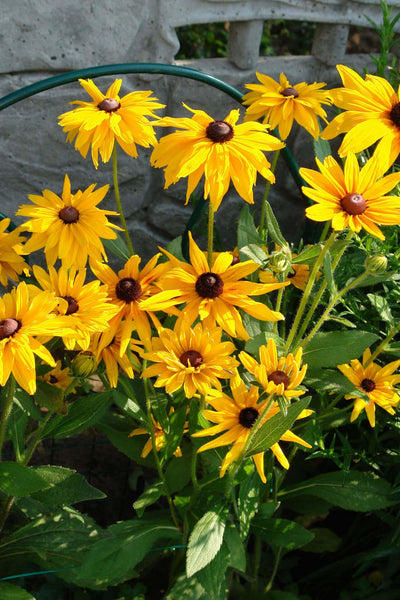
Perennials: The Heart of Your Garden
Perennials serve as the perfect base for a no-fuss perennial garden. Simple because of their resilience to freezing temperatures, a perennial garden is an investment that pays off season after season. Let us dive straight to the core of the plants that define a majority of gardens with an emphasis on how to utilize them to your advantage.
Why Plant Perennials?
The word Perennial is derived from the Latin word ‘Perennis’ which translates to ‘through the year’. A truly remarkable quality of Perennial plants is their ability to come alive for more than a season, sometimes coming back for multiple consecutive years, or even with the right maintenance for decades. This is a luxury that annual plants do not have as they need to be replanted every year because they do not come from their own roots. This is what makes perennial vs annual plants the ideal choice for a gardener.
How Do Perennials Work?
The evolution of perennials is fascinating. These plants have some real survival skills. Many perennials have bulbs, tubers, and rhizomes, These structures help perennials tide over exceedingly harsh winters and droughts. These structures store nutrients underground, letting the plant grow and multiply when the time is right. This is what makes regions with unpredictable climates so fascinating when it comes to perennials. It guarantee’s the garden will bounce back even after the coldest, harshest winters.
Key Benefits of Perennials Plants
Perennial gardening comes with numerous benefits. Some of these benefits of perennial gardening have made it a favorite for both seasoned gardeners and new gardeners.
Longevity
Perennial plants will live for numerous seasons. Plants will survive and bloom year after year, which makes them a better option than annuals.
Little whole plant maintenance
Compared to other plants of annuals, perennials require little whole plant maintenance especially after the
Blooming Season
Perennial plants will bloom and se their seeds. Set-up a garden with these perennial plants to have unobstructed blooms from spring well into fall.
Cost-effectiveness
Even though perennials may be more expensive at the onset than annuals, they are more rewarding in the long run since there is no need to purchase new plants every year.
Types of perennials
There is a wide range of perennials, with some featuring exquisite flowers while others are just pure greenery. Here are the major categories:
Flowering perennials
Flowering perennials are most appreciated for the flowers they bring. Such flowers add color and texture to the landscape. Depending on the variety of plants, some perennials bloom on a particular time of the season while others bloom at other times, thus contributing to the “something blooming all the time” idea. Some of the most loved flowering perennials are:
- Peonies: Such flowers are considered some of the showiest. They bloom at the late spring and early summer, and then can be expected to outlive the owners in the garden.
- Daylilies: They are loved for the bright and cheerful colors they bring to lucky patches of sunshine.
- Hibiscus: Their beauty is remarkable, with dramatic and tropical blooms.
- Coneflowers: Resembling blooming daisies, these flowers are appreciated for being hardy and for attracting some of the trendy pollinators, namely bees and butterflies.
Non-Flowering Perennials
Even though flowering perennials get all the glory, non-flowering perennials are just as essential for adding structure and greenery to the garden. These plants are usually in the background, helping to fill empty spaces and adding contrast to the garden. Some examples are:
- Ferns: Ideal for shady spaces, ferns are great for adding softness and depth to the garden greenery.
- Conifers: These evergreen plants offer greenery all year round, even in the dead of winter.
- Boxwood Shrubs: Best known for their compact and neat growth, boxwoods are perfect for hedges and borders.
Sun vs. Shade Perennials
When it comes to selecting the appropriate perennials for your garden, the light exposure has to be taken into consideration. There are some perennials that will do great in full sun, while others prefer to be in the shade. Here’s a quick reference:
- Shade Perennials: Ferns, hostas, and astilbes are great for the garden’s shady spots where there isn’t much light because these plants do not need much light, and can even thrive in deep shade.
- Sun Perennials: Plants such as lavender, black-eyed Susans, and sunflowers need a minimum of 6 hours of direct sunlight in order to do well. These plants are ideal for garden spots where there is plenty of sunlight.
Planting Perennials
With beating the heat of the sun while getting beat by the roots under the muddy warm soil, it can be quite difficult. Thus, proper planning needs to be in order. Here is how we can work in conjunction with mother nature to achieve the optimum results.
Pick the Correct Specimens
As mentioned, there are sunny and shady living arrangements. Therefore, opt for the shady- and sun-loving perennial to pick plants suited for the conditions in the garden.
- Prepare the Soil:Preparing the soil follows soil moisture and texture concern. Therefore, the soil needs to be sandy and loamy and minerals with good drainage. To achieve desired texture, use good organic compost.
- Watering:Watering is also an essential practice in order to promote healthy root growth. Of course watering needs to be balanced and moderate. Otherwise, root rot may occur especially in combining cooler climates.
- Fertilizing:To give the plants an ideal start, slow release fertilizing in spring is the best. Once dormant, plants need to be awake and get ready to bloom again.
- Deadheading:During the last days of spring and the start of summer, deadheading is a practice in order to subtract spent flowers in order to allow for more blooms. This practice is monitored in order to let plants focus their growth more on the new buds.
- Mulching for Winter:For the plants to not shrivel and die, the roots need to be insulated. During extremely cold climates, plants should be mulched to give this needed insulation for the roots.
Visit TN Nursery for Premium Perennials
If you want to add some premium perennials to your garden, TN Nursery has a great selection. Perennial flowers, tropical greens, and other forms, are available and suited for any garden. We guarantee these perennial plants will flourish beautifully for a long time.
FAQs
What is the 3-year perennial rule?
The “3-year rule” is how long it takes perennials to settle in your garden. In the first year, the plants concentrate on developing roots. In the second year, they’ll start to grow. By the third year, they should be an established, blooming plant, and you should see a substantial plant. Make sure to be patient as your plants become well established!
What is the 70/30 rule in gardening?
The 70/30 rule is a guideline about the ratio of sun/shade perennials. It recommends that 70% of your plants should be sun lovers, while the rest should be shade tolerant. This balance provides your garden with a variety of plants, and will also support a wider range of plants to support different light conditions.
What plant comes back every year in perennials?
Perennials offer their roots, rhizomes, or bulbs, and they will reappear every year. Popular perennial plants that return every year are the classic peonies, daylilies, lavender, and coneflowers. These plants will regenerate every year and offer beauty and variety in your garden with minimal effort.
What Is the Rule of 3 in Gardening?
For more balanced and aesthetically pleasing designs, clusters of plants should be arranged in odd numbers. This natural placement, harmony, and balance of integration flow occur with plantings in threes, as well as in other designs.
What the most common mistake of first time gardeners?
Overwatering plants is one of the most common mistakes of first-time gardeners. New gardeners tend to overwater thinking it will promote better plant growth; however, overwatering plants will lead to root rot and other plant diseases. This plant disease is preventable if a new gardener learns the watering needs of the plant, and the soil must be checked for moisture before it is watered.
Is it okay to plant plants in October?
Yes. October is a great time to plant many perennials, especially those that are hardy in your climate. Fall planting allows root establishment before the cold months, and these plants will be ready to burst in growth for spring. Mulch your plants to protect against frost.






